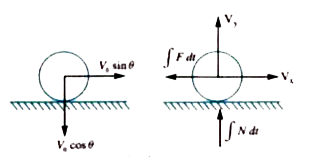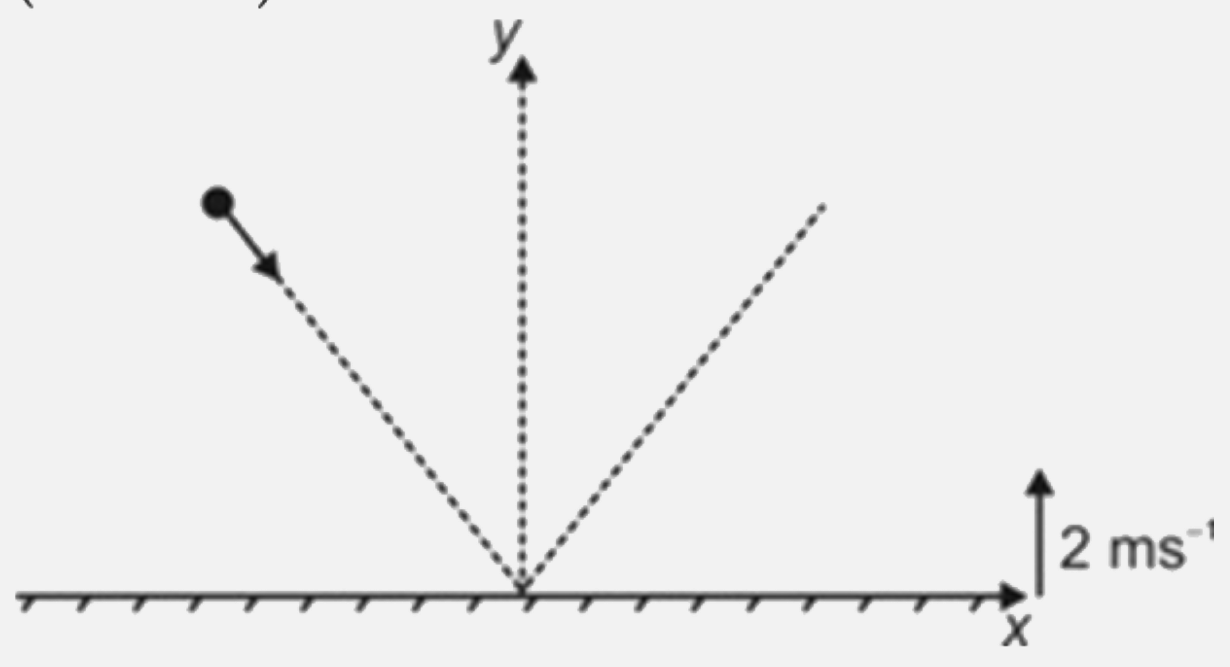A small rubber ball strikes a rough horizontal surface with a velocity v, at an angle θ with vertical. If the coefficient of restitution and coefficient of friction between the ball and horizontal surface are e and u respectively, find the velocity of the ball just after the impact.
As the particle collides with the rough horizontal impulse of ∫N dt and horizontal impulse be ∫Fdt where friction F=μN….(i)

Writing the impulse momentum equation for the particle in x-direction, we have, mv0sinθ−∫Fdt=mvx.....(ii)
Similarly, the impulse momentum equation in y-direction gives −mv0cosθ+∫Ndt=mvy....(iii)
The coefficient of restitution along y-direction (normal) gives vy=−e(−v0costhea)
Then vy=ev0cosθ ...(iv)
We have four equations for four unknown quantities , i.e., ∫dt,∫Ndt,vxandvy.
Substituting F=μN in eq. (ii) and eliminating ∫Ndt from eqs. (ii) and (iii), we have
vx=v0[sinθ−μ(1+e)cosθ]......(v)
From eqs. (iv)and(v), we have, [v0sinθ−μ(1+e)cosθ]ˆi+ev0cosθˆj.
Topper's Solved these Questions
- COLLISIONS BOOK - AAKASH SERIESCHAPTER - COLLISIONS EXERCISE - VERY SHORT ANSWER TYPE QUESTIONS
12 Videos
- COLLISIONS BOOK - AAKASH SERIESCHAPTER - COLLISIONS EXERCISE - NUMERICAL EXERCISE ( LEVEL 1)
18 Videos
- CENTRE OF MASSBOOK - AAKASH SERIESCHAPTER - CENTRE OF MASSEXERCISE - ADDITIONAL PRACTICE EXERCISE (PRACTICE SHEET (ADVANCED))
3 Videos
- ELASTICITYBOOK - AAKASH SERIESCHAPTER - ELASTICITYEXERCISE - Questions for Descriptive Answers
10 Videos
Similar Questions
A ball is thrown from the ground with velocity u at an angle θ with horizontal. If the coefficient of restitution is e , find the time of flight , the maximum height and the horizontal range after the first collision.
View SolutionA steel ball strikes a fixed smooth steel plate placed on a horizontal surface atan angle θ with the vertical. If the coefficient of restitution is e, the angle at which the rebound will take place is:
View Solution
Knowledge Check
A steel ball strikes a fixed smooth steel plate placed on a horizontal surface at an angle θ with the vertical. If the coefficient of restitution is e, the angle at which the rebound will take place is:
AθBtan−1[tanθe]CetanθDtan−1[etanθ]A ball is projected from a point in a horizontal plane with a velocity of 20 m/s at 30∘ with the horizontal. Coefficient of restitution is 0.8, then
Aduration for which ball will rebound is 20 sBduration for which ball will rebound is 10 sChorizontal component of velocity of the ball is 17.3 m/s.Dhorizontal distance before the ball ceases to rebound is 173 mA glass ball collides with a smooth horizontal surface (xz plane) with a velocity V=ai−bj. If the coefficient of restitution of collision be e, the velocity of the ball just after the collision will be
A√e2a2+b2 at angle tan−1(aeb) to the verticalB√a2+e2b2 at angle tan−1(aeb) to the verticalC√a2+b2e2 at angle tan−1(eab) to the verticalD√a2e2+b2 at angle tan−1(aeb) to the vertical
A steel ball strikes a fixed smooth steel plate placed on a horizontal surface at an angle θ with the vertical. If the coefficient of restitution is e, the angle at which the rebound will take place is:
View SolutionA ball is projected from a point in a horizontal plane with a velocity of 20 m/s at 30∘ with the horizontal. Coefficient of restitution is 0.8, then
View SolutionA glass ball collides with a smooth horizontal surface (xz plane) with a velocity V=ai−bj. If the coefficient of restitution of collision be e, the velocity of the ball just after the collision will be
View SolutionConsider a horizontal surface moving vertically upward with velocity 2ms−1. A small ball of mass 2 kg is moving with velocity (2ˆi−2ˆj)ms−2 If the coefficient of restitution and coefficient of friction are 12and13 respectively, find the horizontal velocity (in ms−1) of the ball after the collision.

View SolutionConsider a horizontal surface moving vertically upward with velocity 2ms−1. A small ball of mass 2 kg is moving with velocity (2ˆi−2ˆj)ms−1 If the coefficient of restitution and coefficient of friction are 12and13 respectively, find the horizontal velocity (in ms−1) of the ball after the collision.

View Solution
